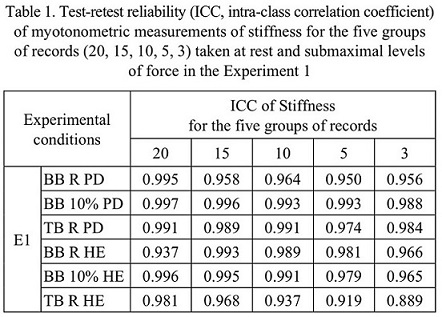Publications

Influence of number of records on reliability of myotonometric measurements of muscle stiffness at rest and contraction
Authors: Jarosław Marusiak 1, Ewa Jarocka 2, Anna Jaskólska 1, Artur Jaskólski 1
Affiliations:
- Department of Kinesiology, Faculty of Physiotherapy, University School of Physical Education, Wrocław, Poland
- Physiology Section, Department of Integrative Medical Biology, Umea University, Umea, Sweden
Journal: Acta of Bioengineering and Biomechanics - January 2018, Volume 20, No.3, 123-131 (DOI: 10.5277/ABB-01153-2018-03)
-
Field & Applications:
- Medical
- Methodology
- Neurology
- Reliability
- Sport
- Validity
Thus, when a researcher performs the myotonometric measurements in such time-limited sessions (and especially in multimodal projects where myotonometry is one among many other methods used during the session), we recommend to choose the option of lower number of records.
In this case, the reliable myotonometric measurements might be performed even with 3 to 5 records at resting condition, but for the measurements at submaximal levels of force at least 5 records should be taken to be sure about the measurements reliability.
Purpose: The aim of this study was to determine an effect of myotonometric records’ number on stiffness measurements’ reliability in muscles at rest and contraction.
Methods: Muscle stiffness was measured using Myoton-3 device. Twenty records were taken for: (i) biceps (BB) and triceps brachii (TB) at rest and for BB at 10% of maximal voluntary contraction (MVC) in healthy elderlies (HE) and in Parkinson’s disease patients (PD); and (ii) brachioradialis (BR) at rest and at 25, 50 and 80% MVC in healthy young (HY) subjects. Also, in HY group, the 3-records mode was used for BR’s measurements at maximal contraction. Each measurement taken with 20-records was classed into five records groups: the whole 20- and the first 15-, 10-, 5- and 3-records. Test-retest reliability for these records groups was analyzed.
Results: In HE and PD group measurements’ reliability was excellent for all groups of records (20-3 records). In HY group, for the five groups of records taken at rest and submaximal levels of contraction (25, 50 and 80% MVC) the measurements reliability: (i) was mostly excellent or rarely average; and (ii) only in one per three 50% MVC conditions was unacceptable, i.e., for the 3-records group. The reliability of 3-records mode measurements at maximal contraction were unacceptable.

In the healthy elderly subjects and in individuals with PD, the myotonometric measurements’ reliability at rest and low level of muscle contraction was excellent for all groups of records (20, 15, 10, 5 and 3 records). In the healthy young subjects, for the five groups of records taken at rest and most of measurements at sub- maximal levels of force (25, 50 and 80% of MVC), the reliability was excellent or rarely average, and only in one per three measurements at 50% MVC the reliability was unacceptable (for the 3-records group). To sum up, the reliable myotonometric stiffness measurements in muscles at rest and during submaximal contractions can be achieved with less than 20 records (15, 10, 5 records) and even for most measurements with 3 records in healthy young and elderly subjects as well as in the PD patients. However, the myotonometric stiffness measurements with 3-records mode during maximal contraction were not reliable in healthy young subjects.


